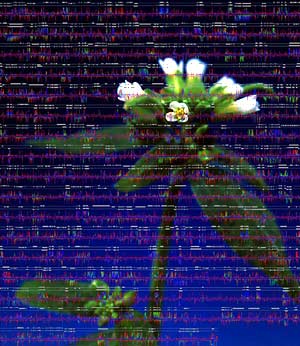Berkeley, California
October 30, 2003
By Sarah Yang, Media Relations
In a study led by researchers at the
University of California,
Berkeley, and the Salk
Institute in La Jolla, Calif., scientists have accurately
mapped the genes of the common mustard weed, Arabidopsis. The
achievement may lead to the next generation of genetically
modified crops that can grow faster, produce more food and
resist disease.
The study, which appears in the Oct. 31 issue of Science,
reveals the existence of nearly 6,000 genes, about one-third of
the genes that exist in Arabidopsis. Knowing these genes
and how they work can allow researchers - in a short period of
time - to use them to change the characteristics of other
plants.
|
"Arabidopsis has all the genes a plant needs," said
Joe Ecker, Salk professor of plant biology. "All flowering
plants are closely related, and so the genes that encode
various traits are also shared. It's possible, then, to take
a gene for flowering from Arabidopsis and insert it
into rice or poplar, and have that gene function."
Ecker and Athanasios Theologis, adjunct professor at UC
Berkeley's College of Natural Resources and senior scientist
at the Plant Gene Expression Center, are the principal
investigators on the project, which includes a team of 72
scientists from nine institutions in the United States and
Japan. The Plant Gene Expression Center is a collaboration
between UC Berkeley's Department of Plant and Microbial
Biology and the USDA's Agricultural Research Service.
The findings revealed some shortcomings of computer-based
gene prediction programs, including those that have been
used to sequence the human genome and the Arabidopsis
plant - the plant biologists' equivalent of the fruit fly
for genetics research.
The researchers point out that computer algorithms can't
always distinguish whether a piece of code corresponds to a
single gene or to two overlapping genes. And while the
programs have become increasingly accurate in recent years,
the researchers added, computer programs may still put
genes' parts in the wrong places, find genes that aren't
really there, or miss genes altogether. What researchers say
they often get from an initial sequence of a genome is a
"best-estimate" lineup of transcription units. |

An image of the Arabidopsis plant superimposed with
readings of its whole genome array.
(Image by Jamie Simon, Salk Institute and Peggy Greb, USDA
Agricultural Research Service) |
To get the real picture of what's there and what's not,
researchers say they need empirical, experimental verification.
The research team placed the entire Arabidopsis genome,
consisting of about 25,000 suspected genes, on a series of six
gene chips, and then analyzed the chips for any protein-making
activity, the primary function of genes. They isolated one-third
of the plant's genes, which will be publicly available for
researchers to fix errors in the current blueprint of the
genome. In addition to finding shortcomings in the
much-heralded, computerized methods of sequencing a genome, they
discovered about 3,300 functioning genes for the first time.
"By putting the entire genome on the gene chips, we could find
that what the computers predicted as genes were wrong about a
third of the time," said Ecker. "But we also found other genes
we had not seen before. Genetically, plants are much simpler
than animals, so this information can be used almost immediately
to improve crop yields and disease resistance."
"We eventually want to be able to understand the function of all
the proteins within an organism," said Theologis. "If you know
the correct gene structure, you can clone DNA to express and
study proteins. This type of research eventually will lead to
advances in proteomics."
Many of the researchers on this study were part of the team that
sequenced the genome of Arabidopsis nearly three years
ago. The initial genome work and the current research are funded
by the National Science Foundation (NSF), which established a
project to identify an entire plant genome by 2010.
"The technology used in this research will be able to reveal the
dark matter in a genome," said Theologis. "We will be able to
identify never-before-seen RNA in regions that were once thought
to contain no genes. Researchers could also use this method to
get a more definitive answer to how many genes are in the human
genome."
"Finding the genes that lurk in the DNA sequence sounds like an
easy problem, but in fact is tremendously challenging," said
Robert Last, program director of the NSF's plant genome research
program. "Completion of the DNA sequence of a genome such as
Arabidopsis is an important milestone towards understanding
the function of every gene in the plant, and discovering the
genes that can positively influence the productivity,
nutritional and medical value of the plant to human beings." |